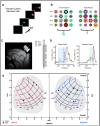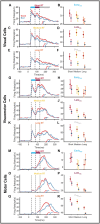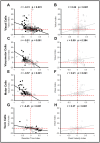This is a preprint.
Multiple groups of neurons in the superior colliculus convert value signals into saccadic vigor
- PMID: 40667199
- PMCID: PMC12262230
- DOI: 10.1101/2025.06.24.661386
Multiple groups of neurons in the superior colliculus convert value signals into saccadic vigor
Abstract
Eye movements directed to high-valued objects in the environment are executed with greater vigor. Superior Colliculus (SC) - a subcortical structure that controls eye movements - contains multiple subtypes of neurons that have distinct functional roles in generating saccades. How does value-related information processed in other parts of the brain affect the responses of these different subtypes of SC neurons to facilitate faster saccades? To test this, we recorded four subtypes of neurons simultaneously while the monkey made saccades to objects they had been extensively trained to associate with large or small rewards (i.e., good or bad). In three subtypes of neurons (visual, visuomotor, and motor), the good objects elicited more spikes than bad objects. More importantly, using a bootstrapping procedure, we identified three separable phases of activity: 1) early visual response (EVIS), 2) late visual response (LVIS), and 3) pre-saccadic (PreSAC) motor response in these neuronal subtypes. In each subtype of neurons, the value of objects (good vs. bad) was positively correlated with the activity in the LVIS and PreSAC phases but not the EVIS phase. These data suggest that the value information from other brain regions modulates the visual (LVIS) and the motor (PreSAC) responses of visual, visuomotor, and motor neurons. This enhanced activation facilitates the faster initiation and execution of the saccade based on the value of each object. In addition, we found a novel class of tonically active neurons that decrease their activity in response to object onset and remain inhibited till the end of the saccade. We suggest that these tonic neurons facilitate the saccade to objects by disinhibiting the interactions between the other three SC neurons.
Keywords: Peak Saccade Velocity; Reaction Time; Reward Modulation; Superior Colliculus; Value-based Behavior.
Conflict of interest statement
Disclosures No conflicts of interest, financial or otherwise, are declared by the authors.
Figures









Similar articles
-
Short-Term Memory Impairment.2024 Jun 8. In: StatPearls [Internet]. Treasure Island (FL): StatPearls Publishing; 2025 Jan–. 2024 Jun 8. In: StatPearls [Internet]. Treasure Island (FL): StatPearls Publishing; 2025 Jan–. PMID: 31424720 Free Books & Documents.
-
Saliency Response in Superior Colliculus at the Future Saccade Goal Predicts Fixation Duration during Free Viewing of Dynamic Scenes.J Neurosci. 2025 Jan 15;45(3):e0428242024. doi: 10.1523/JNEUROSCI.0428-24.2024. J Neurosci. 2025. PMID: 39572235 Free PMC article.
-
The Black Book of Psychotropic Dosing and Monitoring.Psychopharmacol Bull. 2024 Jul 8;54(3):8-59. Psychopharmacol Bull. 2024. PMID: 38993656 Free PMC article. Review.
-
Diverse and dynamic influences of saccades on visual representations in the mouse superior colliculus.Proc Natl Acad Sci U S A. 2025 Jul 22;122(29):e2425788122. doi: 10.1073/pnas.2425788122. Epub 2025 Jul 16. Proc Natl Acad Sci U S A. 2025. PMID: 40668831
-
Comparison of self-administered survey questionnaire responses collected using mobile apps versus other methods.Cochrane Database Syst Rev. 2015 Jul 27;2015(7):MR000042. doi: 10.1002/14651858.MR000042.pub2. Cochrane Database Syst Rev. 2015. PMID: 26212714 Free PMC article.
References
-
- Amador N., Schlag-Rey M., & Schlag J. (2000). Reward-predicting and reward-detecting neuronal activity in the primate supplementary eye field. Journal of Neurophysiology, 84(4), 2166–2170. - PubMed
-
- Bahill A. T., Clark M. R., & Stark L. (1975). The main sequence, a tool for studying human eye movements. Mathematical Biosciences, 24(3–4), 191–204.
Publication types
LinkOut - more resources
Full Text Sources
Research Materials
